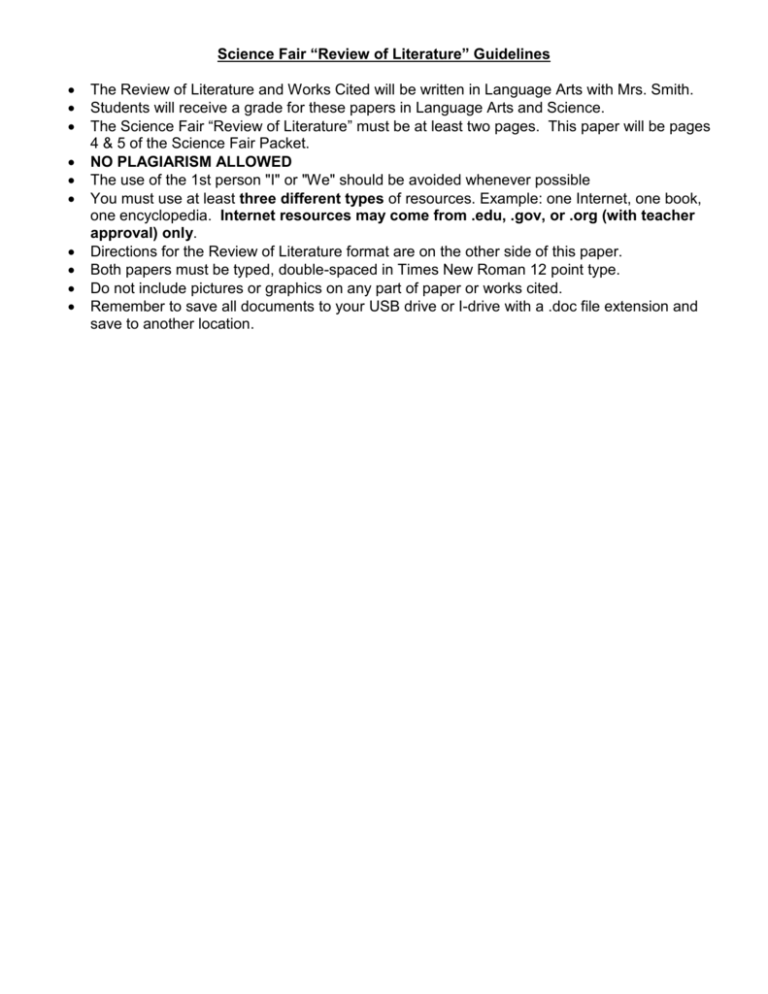Science Fair “Review of Literature” Guidelines
advertisement

Science Fair “Review of Literature” Guidelines The Review of Literature and Works Cited will be written in Language Arts with Mrs. Smith. Students will receive a grade for these papers in Language Arts and Science. The Science Fair “Review of Literature” must be at least two pages. This paper will be pages 4 & 5 of the Science Fair Packet. NO PLAGIARISM ALLOWED The use of the 1st person "I" or "We" should be avoided whenever possible You must use at least three different types of resources. Example: one Internet, one book, one encyclopedia. Internet resources may come from .edu, .gov, or .org (with teacher approval) only. Directions for the Review of Literature format are on the other side of this paper. Both papers must be typed, double-spaced in Times New Roman 12 point type. Do not include pictures or graphics on any part of paper or works cited. Remember to save all documents to your USB drive or I-drive with a .doc file extension and save to another location. FORMAT FOR SCIENCE FAIR “REVIEW OF LITERATURE” First Paragraph: Introduction Tell what your science fair topic and purpose of experiment is going to be. For example: The purpose of this science fair experiment was to discover which plant grows best under certain conditions. In order to better understand the experiment, research was done on the process of photosynthesis. Tell what your three resources were for your research. For example: Research sources included a magazine article from Science Today, a website produced by NASA, and a chapter from my science textbook. Write a conclusion sentence that summarizes the most important fact that you learned from your research. For example: The research led the reader to the basic conclusion that plants must have light in order to complete the process of photosynthesis. Second Paragraph: First Source Use the handout you filled out for your first source for the bibliographic information. Give the bibliographic information in sentence form. For example: The first source reviewed was a book written by Travis Klein titled The Habitat of Rainbow Trout. Use your notes to summarize the information you found from this source. Remember that if you write any information word-for-word, you must put it in direct quotes. You should have at least three facts from each source! End the paragraph with a concluding sentence that summarizes the information you got from this source. Third Paragraph: Second Source Follow the above process to write the information from your second source. Fourth Paragraph: Third Source Follow the above process to write the information from your third source. Fifth Paragraph: Conclusion Write a sentence or two that summarizes the overall facts and information you gathered from your research. For example: Overall, the research indicated the importance of genetics in determining the eye color of children. Explain a fact that you found surprising or interesting. For example: One of the most interesting things learned in the research on starfish was the concept of regeneration. When a starfish loses an arm through an accident or disease, it will grow one back. Explain how you think this information will affect your hypothesis. For example: Knowing this information will affect the science fair project because the reader now knows that the controlled variable needs to be the same length of time in each testing situation. Write a conclusion sentence that explains the value of doing this research of literature before continuing with your science fair project. For example: Researching and reviewing these three sources gave the exhibitor a much better understanding of simple machines. This knowledge will help the exhibitor to complete a more successful experiment and project.








